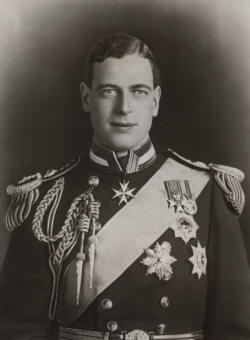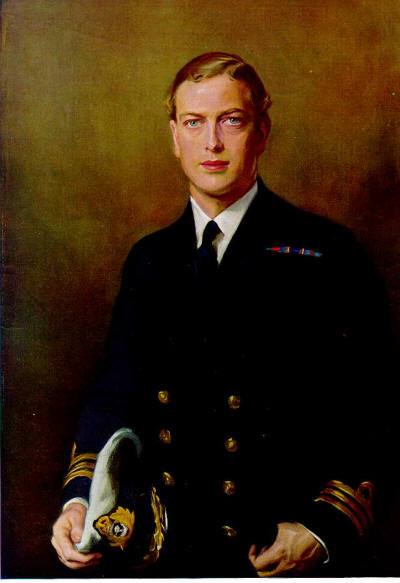

Queer Places:
Royal Burial Ground, Frogmore
 Prince George, Duke of Kent, KG, KT, GCMG, GCVO (George Edward Alexander Edmund; 20 December 1902 – 25 August 1942) was a member of the British royal family, the fourth son of King George V and Queen Mary. He was the younger brother of Edward VIII and George VI.
Prince George served in the Royal Navy in the 1920s and then briefly as a civil servant. He became Duke of Kent in 1934. In the late 1930s he served as an RAF officer, initially as a staff officer at RAF Training Command and then, from July 1941, as a staff officer in the Welfare Section of the RAF Inspector General's Staff. He was killed in a military air-crash on 25 August 1942.
Noël Coward had a 19-year friendship with Prince George,
Duke of Kent, but
biographers differ on whether it was platonic. Graham Payn believed that it was, although Coward reportedly admitted to the
historian Michael Thornton that there had been "a little dalliance".
Coward said, on the duke's death, "I suddenly find that I loved him more than
I knew."
Prince George, Duke of Kent, KG, KT, GCMG, GCVO (George Edward Alexander Edmund; 20 December 1902 – 25 August 1942) was a member of the British royal family, the fourth son of King George V and Queen Mary. He was the younger brother of Edward VIII and George VI.
Prince George served in the Royal Navy in the 1920s and then briefly as a civil servant. He became Duke of Kent in 1934. In the late 1930s he served as an RAF officer, initially as a staff officer at RAF Training Command and then, from July 1941, as a staff officer in the Welfare Section of the RAF Inspector General's Staff. He was killed in a military air-crash on 25 August 1942.
Noël Coward had a 19-year friendship with Prince George,
Duke of Kent, but
biographers differ on whether it was platonic. Graham Payn believed that it was, although Coward reportedly admitted to the
historian Michael Thornton that there had been "a little dalliance".
Coward said, on the duke's death, "I suddenly find that I loved him more than
I knew."
There were persistent rumours that George, Duke of Kent had a 19-year affair with the actor and composer Noël Coward. The British security services supposedly reported that Coward and George were seen parading the streets in London in drag and had once been arrested by police for suspected prostitution. Love letters from George to Coward were believed to have been stolen from Coward’s house in 1942, and another clutch of letters had to be bought back from a male prostitute in Paris who was blackmailing him. Additional gossip suggested that George dallied with his distant cousin Prince of Prussia Louis Ferdinand and with art historian and, later, Soviet spy Anthony Blunt.
Although his career had been of no great distinction, Sir Charles Mendl's knighthood was allegedly bestowed due to his retrieval of letters from a gigolo who had been blackmailing Prince George, Duke of Kent. Mendl was the husband of lesbian interior designer Elsie de Wolfe. In 1930, while on a trip to Australia, it became common knowledge in London society that one of the men escorting William Lygon, 7th Earl Beauchamp, Robert Bernays, a member of the Liberal Party, was a lover. The King was horrified, rumoured to have said, "I thought men like that shot themselves". The King had a personal interest in the case, as his sons Prince Henry, Duke of Gloucester, and Prince George, Duke of Kent, had visited Madresfield in the past. George was then in a relationship with Beauchamp's daughter Mary, which was cut off by her father's outing.

Portrait by Philip de László, 1934
Prince George was born on 20 December 1902 at York Cottage on the Sandringham Estate in Norfolk, England.[1] His father was the Prince of Wales (later King George V), the only surviving son of King Edward VII and Queen Alexandra. His mother was the Princess of Wales (later Queen Mary), the only daughter and eldest child of the Duke and Duchess of Teck. At the time of his birth, he was fifth in the line of succession to the throne, behind his father and three older brothers Edward, Albert and Henry. George was baptised in the Private Chapel at Windsor Castle on 26 January 1903 by Francis Paget, Bishop of Oxford.[2][3]
Prince George received his early education from a tutor and then followed his elder brother, Prince Henry, to St Peter's Court, a preparatory school at Broadstairs, Kent. At the age of 13, like his brothers, the Prince of Wales (later King Edward VIII) and Prince Albert (later King George VI), before him, he went to naval college, first at Osborne and, later, at Dartmouth.[1] He was promoted to sub-lieutenant on 15 February 1924,[4] and was promoted to lieutenant on 15 February 1926.[5] He remained on active service in the Royal Navy until March 1929, serving on HMS Iron Duke and later on the flagship of the Atlantic Fleet (renamed the Home Fleet in 1932), HMS Nelson.[1] He served on the latter as a Lieutenant on the Admiral's staff before transferring in 1928 to HMS Durban on the America and West Indies Station, based at the Royal Naval Dockyard at Bermuda (where his father had previously served on HMS Canada and HMS Thrush), as a watch-keeping Lieutenant.[6] After leaving the navy, he briefly held posts at the Foreign Office and later the Home Office, becoming the first member of the royal family to work as a civil servant.[1] He continued to receive promotions after leaving active service: to commander on 15 February 1934 and to captain on 1 January 1937.[7][8] From January to April 1931, Prince George and his elder brother the Prince of Wales travelled 18,000 miles on a tour of South America. Their outward voyage was on the ocean liner Oropesa.[9] In Buenos Aires they opened a British Empire Exhibition.[10] They continued from Río de la Plata to Rio de Janeiro on the liner Alcantara and returned from Brazil to Europe on the liner Arlanza, landing at Lisbon.[11] The princes returned via Paris and an Imperial Airways flight from Paris–Le Bourget Airport that landed specially in Windsor Great Park.[12][13] On 23 June 1936, George was appointed a personal aide-de-camp to his eldest brother, the new King Edward VIII.[14] Following the abdication of Edward VIII, he was appointed a personal naval aide-de-camp to his elder brother, now George VI.[15] On 12 March 1937, he was commissioned as a Colonel in the British Army and in the equivalent rank of Group Captain in the Royal Air Force (RAF).[16] He was also appointed as the Colonel-in-Chief of the Royal Fusiliers from the same date.[17] In October 1938 George was appointed Governor-General of Australia in succession to Lord Gowrie with effect from November 1939.[18][19] On 11 September 1939 it was announced that, owing to the outbreak of the Second World War, the appointment was postponed.[20] On 8 June 1939, George was promoted to the ranks of rear admiral in the Royal Navy, major-general in the British Army and air vice-marshal in the Royal Air Force.[21] At the start of the Second World War, George returned to active naval service with the rank of rear admiral, briefly serving in the Intelligence Division of the Admiralty. He was patron of the Society for Nautical Research between 1926–1942.[22]
On 12 October 1934, in anticipation of his forthcoming marriage to his second cousin, Princess Marina of Greece and Denmark, he was created Duke of Kent, Earl of St Andrews, and Baron Downpatrick.[23][24] The couple married on 29 November 1934 at Westminster Abbey.[25] They had three children:
Prince Edward, Duke of Kent (9 October 1935). He married Katharine Lucy Mary Worsley on 8 June 1961. They have three children.
Princess Alexandra, The Hon. Lady Ogilvy (25 December 1936). She married Rt. Hon. Sir Angus James Robert Bruce Ogilvy, son of David Lyulph Gore Wolseley Ogilvy, 12th Earl of Airlie and Lady Alexandra Marie Bridget Coke, on 24 April 1963. They had two children.
Prince Michael of Kent (4 July 1942). He married Marie Christine von Reibnitz on 30 June 1978. They have two children.
There were "strong rumours" that he had affairs with musical star Jessie Matthews,[26] writer Cecil Roberts[27] and Noël Coward,[28] a relationship which Coward's long-term boyfriend, Graham Payn, denied.[29] The Duke of Kent is rumoured to have been addicted to drugs, especially morphine and cocaine, a rumour that reputedly originated with his friendship with Kiki Preston,[30][31][32] whom he first met in the mid-1920s. Reportedly, Prince George shared Kiki in a ménage à trois with Argentine Jorge Ferrara.[33] Other alleged sexual liaisons include José Uriburu, son of the Argentine ambassador to the Court of St James's, José Uriburu Tezanos.[34] In his attempt to rescue his cocaine-addicted brother from the influence of Kiki, Edward, Prince of Wales, attempted for a while to persuade both George and Kiki to break off their contact, to no avail.[35] Eventually, Edward forced George to stop seeing Kiki and also forced Kiki to leave England, while she was visiting George there in the summer of 1929.[36] For years afterwards, Edward feared that George might relapse to drugs if he maintained his contact with Kiki. Indeed, in 1932, Prince George ran into Kiki unexpectedly at Cannes and had to be removed almost by force.[37] It has been alleged for years that American publishing executive Michael Temple Canfield (1926–1969) was the illegitimate son of the Duke of Kent and Kiki Preston. According to various sources, both Kent's brother, the Duke of Windsor, and Loelia, Duchess of Westminster, shared this belief.[38][39][40][41] Canfield was the adopted son of Cass Canfield, American publisher of Harper and Row.[42] In 1953, Canfield married Caroline Lee Bouvier the younger sister of Jacqueline Bouvier who married U.S. Senator and future U.S. president John F. Kennedy the same year. Canfield and Bouvier divorced in 1958, and the marriage was annulled by the Roman Catholic Church in November 1962.[43] Some authors have alleged that like his elder brother, Edward VIII, George was a Nazi sympathiser with ties to Rudolf Hess, but the claim has not been proven.[44]
On 25 August 1942, George and 14 others took off in a RAF Short Sunderland flying boat W4026 from Invergordon, Ross and Cromarty, to fly to Iceland on non-operational duties. The aircraft crashed on Eagle's Rock, a hillside near Dunbeath, Caithness, Scotland. All but one were killed, including George, who was 39 years old.[53] Lynn Picknett and Clive Prince have written about the crash in their book Double Standards, which however has been criticised for its "implausible inaccuracy".[54] They alleged that Kent had a briefcase full of 100-krona notes, worthless in Iceland, handcuffed to his wrist, leading to speculation the flight was a military mission to Sweden, the only place where krona notes were of value.[55] His death in RAF service marked the first time in more than 450 years that a member of the royal family died on active service.[56] The prince's body was transferred initially to St. George's Chapel, Windsor, and he was buried in the Royal Burial Ground, Frogmore, directly behind Queen Victoria's mausoleum. His elder son, six-year-old Prince Edward, succeeded him as Duke of Kent. Princess Marina, his wife, had given birth to their third child, Prince Michael, only seven weeks before Prince George's death. One RAF crew member survived the crash: Flight Sergeant Andrew Jack, the Sunderland's rear gunner.[57] Flight Sergeant Jack's niece has claimed that Jack told his brother that the Duke had been at the controls of the plane; that Jack had dragged him from the pilot's seat after the crash; and that there was an additional person on board the plane whose identity has never been revealed.[58]
My published books: